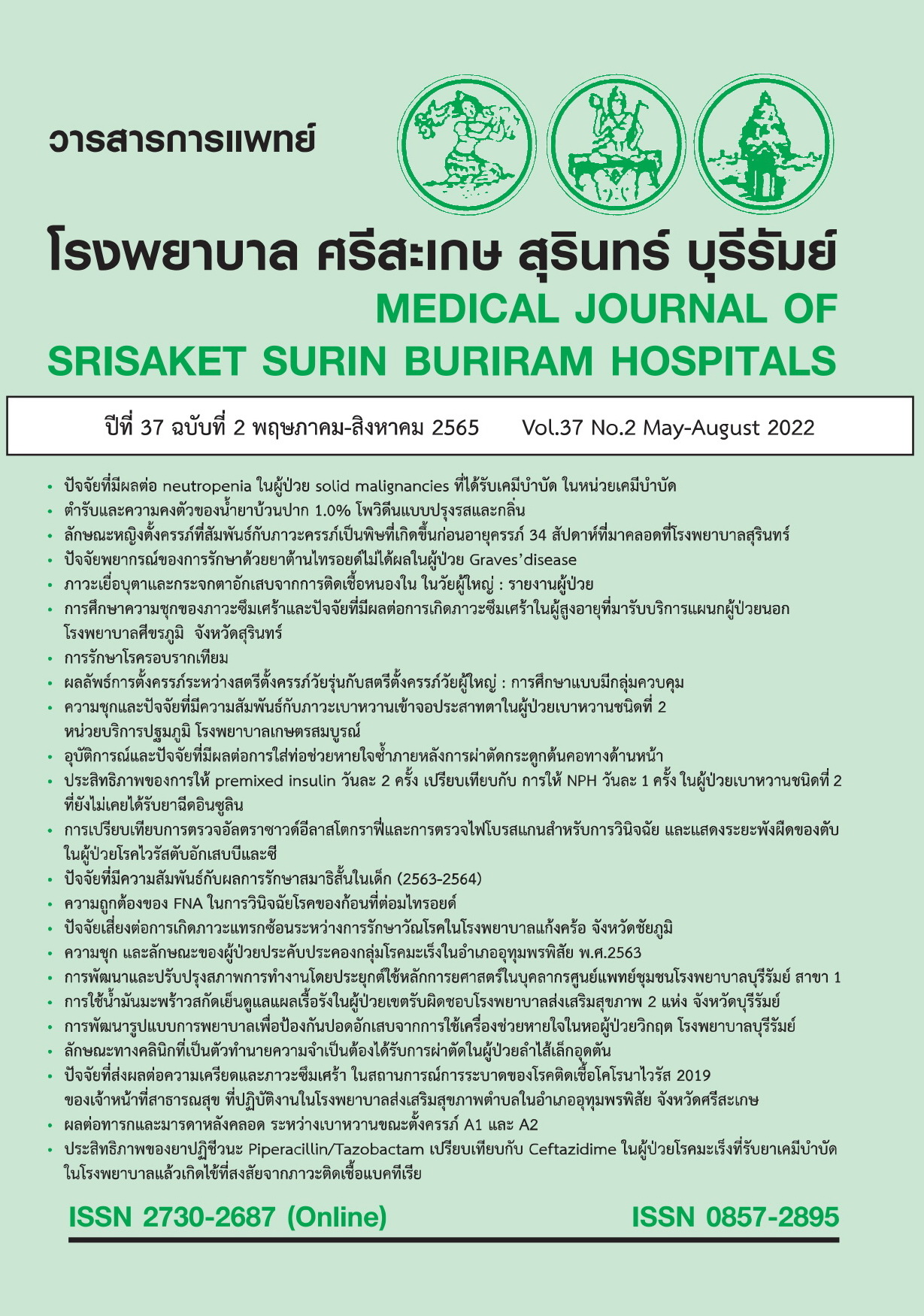ปัจจัยพยากรณ์ของการรักษาด้วยยาต้านไทรอยด์ไม่ได้ผลในผู้ป่วย Graves’disease
Main Article Content
บทคัดย่อ
หลักการและเหตุผล: การรักษาภาวะไทรอยด์เป็นพิษจากโรค Graves’disease มี 3 วิธี ได้แก่ การรับประทานยาต้านไทรอยด์ การกลืนแร่ไอโอดีนรังสี และการผ่าตัดต่อมไทรอยด์โดยทางเลือกในการรักษา ขึ้นอยู่กับปัจจัยบางอย่างของผู้ป่วย ร่วมกับความต้องการของผู้ป่วย โดยผู้ป่วยส่วนใหญ่ มักจะเลือกการกินยาต้านไทรอยด์ก่อนแต่พบว่าผู้ป่วยส่วนหนึ่งไม่หายขาดจากการรักษาด้วยยาต้านไทรอยด์ใน 12 – 24 เดือนและต้องส่งกลืนแร่ หรือผ่าตัดต่อไป แม้จะมีผู้ป่วยส่วนหนึ่งเลือกการกินยาต่อในระยะยาวแล้วหายขาดในภายหลังได้
วัตถุประสงค์: เพื่อศึกษาปัจจัยพยากรณ์ที่ทำให้ การรักษาด้วยยาต้านไทรอยด์ไม่ได้ผลในผู้ป่วย Graves’disease
วิธีการศึกษา: เป็นการศึกษา prognostic factor research รูปแบบ retrospective observational cohort design ในผู้ป่วย Graves’ disease ที่มารักษาที่โรงพยาบาลสุรินทร์ ในช่วงปี พ.ศ.2562 – 2564 จำนวน 460 ราย ทบทวนเวชระเบียนผู้ป่วยนอกในผู้ป่วย Graves’s disease บันทึกข้อมูลพื้นฐาน ประวัติข้อมูลตรวจร่างกาย ผลตรวจทางห้องปฏิบัติการ เปรียบเทียบ 2 กลุ่ม ได้แก่ กลุ่มที่รักษาด้วยยาต้านไทรอยด์แล้วไม่ได้ผล และกลุ่มที่รักษาได้ผล วิเคราะห์ปัจจัยพยากรณ์ด้วยสถิติ multivariable logistic regression
ผลการศึกษา: ผู้ป่วยที่ศึกษาจำนวน 460 ราย จำแนกเป็นกลุ่มที่รักษาด้วยยาต้านไทรอยด์ไม่ได้ผล 227 ราย และได้ผล 233 ราย พบว่าปัจจัยที่พยากรณ์การรักษาด้วยยาต้านไทรอยด์ไม่ได้ผล หลังการวิเคราะห์ด้วย multivariable logistic regression ได้แก่ การมีประวัติเคยเป็นไทรอยด์เป็นพิษมาก่อน (OR=3.06, 95% CI=1.80-5.21, p <0.001), ขนาดของต่อมไทรอยด์ที่มากกว่าหรือเท่ากับ 45 กรัม (OR=4.57, 95% CI=2.80-7.46, p <0.001), การมีอาการแสดงทางตา (Thyroid related orbitopathy) (OR=2.13, 95% CI=1.15-3.96, p =0.016), ระดับ FT4 เมื่อวินิจฉัย (OR=1.37, 95% CI=1.10-1.69, p =0.004) และขนาดยา methimazole ที่ 6 เดือนหลังการรักษายังมากกว่าหรือเท่ากับ 15 มก./วัน (OR=9.20, 95% CI=4.73-17.89, p <0.001)
สรุป: ผู้ป่วย Graves’ disease ที่มีปัจจัยพยากรณ์ดังกล่าว มีโอกาสรักษาด้วยยาต้านไทรอยด์แล้วไม่ได้ผล ควรให้คำแนะนำ หรือเลือกวิธีการรักษาโดยการกลืนแร่ หรือผ่าตัดต่อมไทรอยด์แก่ผู้ป่วยต่อไป
Article Details

This work is licensed under a Creative Commons Attribution-NonCommercial-NoDerivatives 4.0 International License.
References
Ross DS, Burch HB, Cooper DS, Greenlee MC, Laurberg P, Maia AL, et al. 2016 American Thyroid Association Guidelines for Diagnosis and Management of Hyperthyroidism and Other Causes of Thyrotoxicosis. Thyroid 2016;26(10):1343-1421. doi: 10.1089/thy.2016.0229.
Bahn Chair RS, Burch HB, Cooper DS, Garber JR, Greenlee MC, Klein I, et al. Hyperthyroidism and other causes of thyrotoxicosis: management guidelines of the American Thyroid Association and American Association of Clinical Endocrinologists. Thyroid 2011;21(6):593-646. doi: 10.1089/thy.2010.0417.
Azizi F, Malboosbaf R. Long-Term Antithyroid Drug Treatment: A Systematic Review and Meta-Analysis. Thyroid 2017;27(10):1223-31. doi: 10.1089/thy.2016.0652.
Sriphrapradang C. Diagnosis and Management of Graves' Disease in Thailand: A Survey of Current Practice. J Thyroid Res 2020;2020:8175712. doi: 10.1155/2020/8175712.
Burch HB, Burman KD, Cooper DS. A 2011 survey of clinical practice patterns in the management of Graves' disease. J Clin Endocrinol Metab 2012;97(12):4549-58. doi: 10.1210/jc.2012-2802.
Hershman JM. A Survey of Management of Uncomplicated Graves’ Disease Shows that Use of Methimazole Is Increasing and Use of Radioactive Iodine Is Decreasing. children 2010;95(3260).
Brito JP, Schilz S, Singh Ospina N, Rodriguez-Gutierrez R, Maraka S, Sangaralingham LR, et al. Antithyroid Drugs-The Most Common Treatment for Graves' Disease in the United States: A Nationwide Population-Based Study. Thyroid 2016;26(8):1144-5. doi: 10.1089/thy.2016.0222.
Hussain YS, Hookham JC, Allahabadia A, Balasubramanian SP. Epidemiology, management and outcomes of Graves’ disease—real life data. Endocrine 2017;56(3):568-78. doi: 10.1007/s12020-017-1306-5.
Daukšienė D, Daukša A, Mickuvienė N. Independent pretreatment predictors of Graves' disease outcome. Medicina (Kaunas, Lithuania) 2013;49(10):427-34.
Chen DY, Schneider PF, Zhang XS, He ZM, Jing J, Chen TH. Mental health status and factors that influence the course of Graves' disease and antithyroid treatments. Exp Clin Endocrinol Diabetes 2012;120(9):524-8. doi: 10.1055/s-0032-1323807.
Katahira M, Ogata H. Thyroglobulin Autoantibodies Are Associated with Refractoriness to Antithyroid Drug Treatment for Graves' Disease. Intern Med 2016;55(12):1519-24. doi: 10.2169/internalmedicine.55.6095.
Magri F, Zerbini F, Gaiti M, Capelli V, Ragni A, Rotondi M, et al. GENDER INFLUENCES THE CLINICAL PRESENTATION AND LONG-TERM OUTCOME OF GRAVES DISEASE. Endocr Pract 2016;22(11):1336-42. doi: 10.4158/EP161350.OR.
Allahabadia A, Daykin J, Holder RL, Sheppard MC, Gough SCL, Franklyn JA. Age and Gender Predict the Outcome of Treatment for Graves’ Hyperthyroidism. J Clin Endocrinol Metab 2000;85(3):1038-42. doi: 10.1210/jcem.85.3.6430.
Shi H, Sheng R, Hu Y, Liu X, Jiang L, Wang Z, et al. Risk Factors for the Relapse of Graves' Disease Treated With Antithyroid Drugs: A Systematic Review and Meta-analysis. Clin Ther 2020;42(4):662-75.e4. doi: 10.1016/j.clinthera.2020.01.022.
Muir CA, Jones GRD, Greenfield JR, Weissberger A, Samaras K. Thyroid Peroxidase Antibody Positivity is Associated With Relapse-Free Survival Following Antithyroid Drug Treatment for Graves’ Disease. Endocr Pract 2020;26(9):1026-30. doi: 10.4158/EP-2020-0035.
Piantanida E, Lai A, Sassi L, Gallo D, Spreafico E, Tanda M, et al. Outcome Prediction of Treatment of Graves’ Hyperthyroidism with Antithyroid Drugs. Horm Metab Res 2015;47(10):767-72. doi: 10.1055/s-0035-1555759.
Hesarghatta Shyamasunder A, Abraham P. Measuring TSH receptor antibody to influence treatment choices in Graves' disease. Clin Endocrinol (Oxf) 2017;86(5):652-7. doi: 10.1111/cen.13327.
สมาคมต่อมไร้ท่อแห่งประเทศไทย. คำแนะนำสำหรับภาวะความผิดปกติของต่อมไทรอยด์ พ.ศ. 2556. กรุงเทพฯ : กรุเทพเวชสาร; 2556: 38.
Smith TJ, Hegedus L. Graves' Disease. N Engl J Med 2016;375(16):1552-65. doi: 10.1056/NEJMra1510030.
Davies TF, Andersen S, Latif R, Nagayama Y, Barbesino G, Brito M, et al. Graves’ disease. Nat Rev Dis Primers 2020;6(1):52. doi: 10.1038/s41572-020-0184-y.
Diana T, Ponto KA, Kahaly GJ. Thyrotropin receptor antibodies and Graves' orbitopathy. J Endocrinol Invest 2021;44(4):703-12. doi: 10.1007/s40618-020-01380-9.
Kahaly GJ, Diana T, Olivo PD. TSH RECEPTOR ANTIBODIES: RELEVANCE & UTILITY. Endocr Pract 2020;26(1):97-106. doi: 10.4158/EP-2019-0363.
Kahaly GJ. Management of Graves Thyroidal and Extrathyroidal Disease: An Update. J Clin Endocrinol Metab 2020;105(12):3704-20. doi: 10.1210/clinem/dgaa646.
Wiersinga WM. Graves' Disease: Can It Be Cured? Endocrinol Metab (Seoul) 2019;34(1):29-38. doi: 10.3803/EnM.2019.34.1.29.

